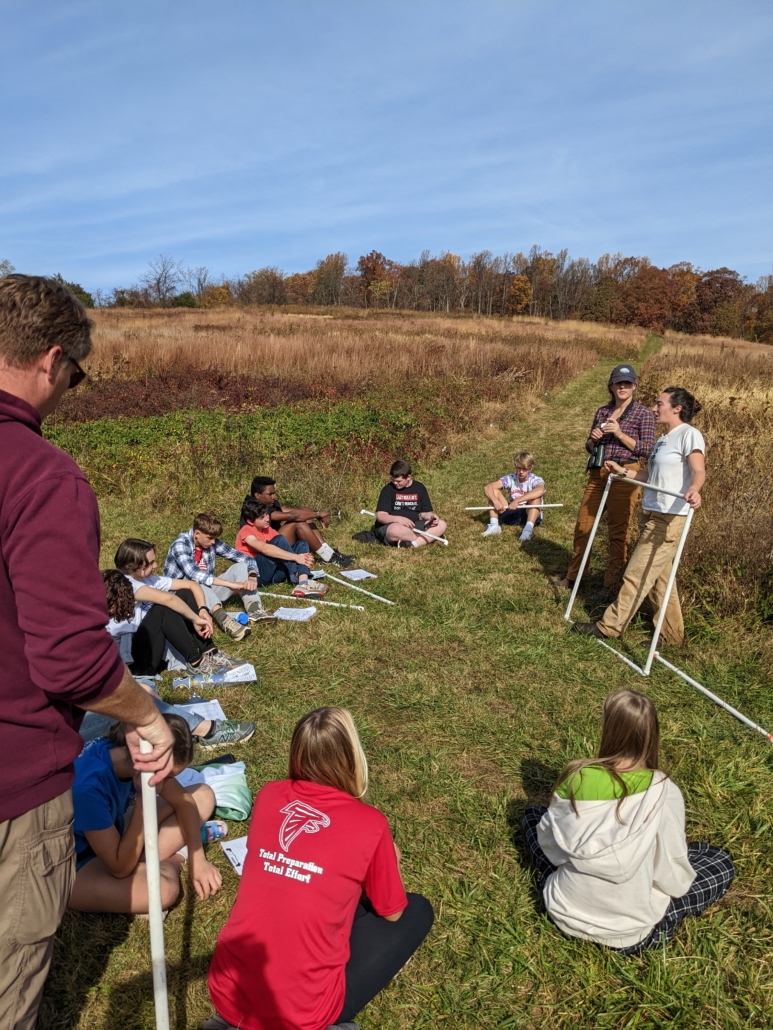New Field Trips Debut: Teaching The Logic of Science With Real-World Results
December 8, 2022
In September of 2022, Education Associate Bridget Bradshaw was standing in the experimental grassland having a conversation with one fifth-grade student about bison husbandry while pulling Swamp Agrimony seeds out of another student’s hair. Students were valiantly thrashing away at the tall vegetation on either side of the trail, diving headfirst into their sweep nets to push the contents into a Ziploc bag. They hoped to find one of the families of Orthoptera they’d spent the last hour learning to identify. Bridget looked at one student’s data sheet on the ground. There was a drawing of an ant and something that was maybe a spider. Next to that, a few big zeros, despite the many grasshoppers hopping just out of reach of the nets.
Bridget gently ended the bison conversation and yelled “last sweep and then we head back!” The students let out mixed cries of relief and disappointment. On the hike back to the peach house, the group wondered: Why didn’t we catch any grasshoppers? Bridget was dreading analyzing the data, worried that the kids would feel like they had failed. This was the first time Bridget had run this field trip, which had been redesigned to let students actively participate in ongoing research at Clifton. But there are very few manuals for designing research methods for large groups of students that range in age from kindergarten to 12th grade and may have little to no field experience, and even Bridget, an experienced educator, wasn’t quite sure what to expect. So why redesign the field trips at all?
Dr. Bruce Alberts, a prominent biochemist and recipient of the 2014 National Medal of Science, published a letter in January, 2022, titled “Why Science Education is More Important than Most Scientists Think.” He writes, “providing a quality education for a nation’s youth is perhaps the most important task that confronts a society, but to do it well is an enormously complex task.”
One of the goals outlined in his letter is to make the logic of science—observation, question, hypothesis, evidence collection, analysis, critical discussion, and sharing of results—so familiar to people that it is used in all parts of life in order to make smart decisions. Many studies have found that actively participating in science coupled with interactions with scientists lead to feelings of increased competency and positive feelings towards science in all ages of people (Bonney et al. 2009). A research field station like the Clifton Institute is an ideal venue to provide authentic science experiences to local communities because 78% of people in the U.S. live within 60 miles of a field station (Struminger et al. 2018). And this is why, in the spring of 2022, Bridget, Co-Director Eleanor Harris and Education Fellow Jacob Ewert sat down to re-write Clifton’s field trip curriculum.
The goal was to design field trips that were not only adjusted to reinforce the state standards expected for each grade level, but to engage each of our 1000-plus annual K-12 students in real science, help them use their data to make real land management suggestions, and then share the trials and errors with other field stations looking to improve their science outreach. Which brings Bridget back to the grassland, covered in seeds, zeros in hand, kids in tow.
Students on this field trip were seeking an answer to the question: “does fire affect the abundance of orthopterans in our experimental grassland?” We want to know because American Kestrels, the tiny falcons whose numbers are declining across the U.S., eat a lot of grasshoppers and other large insects, and nobody has studied the possible effects of different management strategies on prey populations.
The students had split into three groups to survey. Individually they only found a tiny handful of grasshoppers, but they concluded that there were more orthopterans on the mowed side. They wondered about what could explain their findings. Did grasshoppers really only eat grass and there were more grasses on the mowed side? Did the burned side have more blackberry bushes that caught the nets and let the grasshoppers escape capture?
Finally, the three small groups compared data. All three graphs showed the same pattern: higher numbers of orthopterans in the mowed section. The students acknowledged that, given they were only surveying for 40 minutes, this might not be an immutable truth, but still—how amazingly consistent given the new method and a field crew that had been trained just an hour prior!
There’s untapped power in bringing students to a research field station and enlisting them as the field crew for the day. They learn that each tidbit of information gained about the world is paid for in sweat and sometimes blood (the grassland is a thorny place), and they learn that understanding how those “facts” came to be is important in deciding how much weight to place on them. Our hope is that each year going forward, classes will return to watch the landscape change and see the power of compounding data to find patterns in plant communities, vernal pools, wintering waterfowl, the onset of spring, and, of course, grasshoppers because most meaningful discoveries—and certainly the kinds that take decades or centuries to see—are the work of many.
Alberts B. 2022. Why Science Education is More Important than Most Scientists Think. FEBS Letters 596: 149–159.
Bonney R, Ballard H, Jordan R, McCallie E, Phillips T, Shirk J, Wilderman CC. 2009. Public Participation in Scientific Research: Defining the Field and Assessing Its Potential for Informal Science Education. A CAISE Inquiry Group Report. Online Submission.
Stuminger R, Zarestky J, Short R, Lawing AM. 2018. A Framework for Informal STEM Education Outreach at Field Stations. BioScience 68: 969-978.




